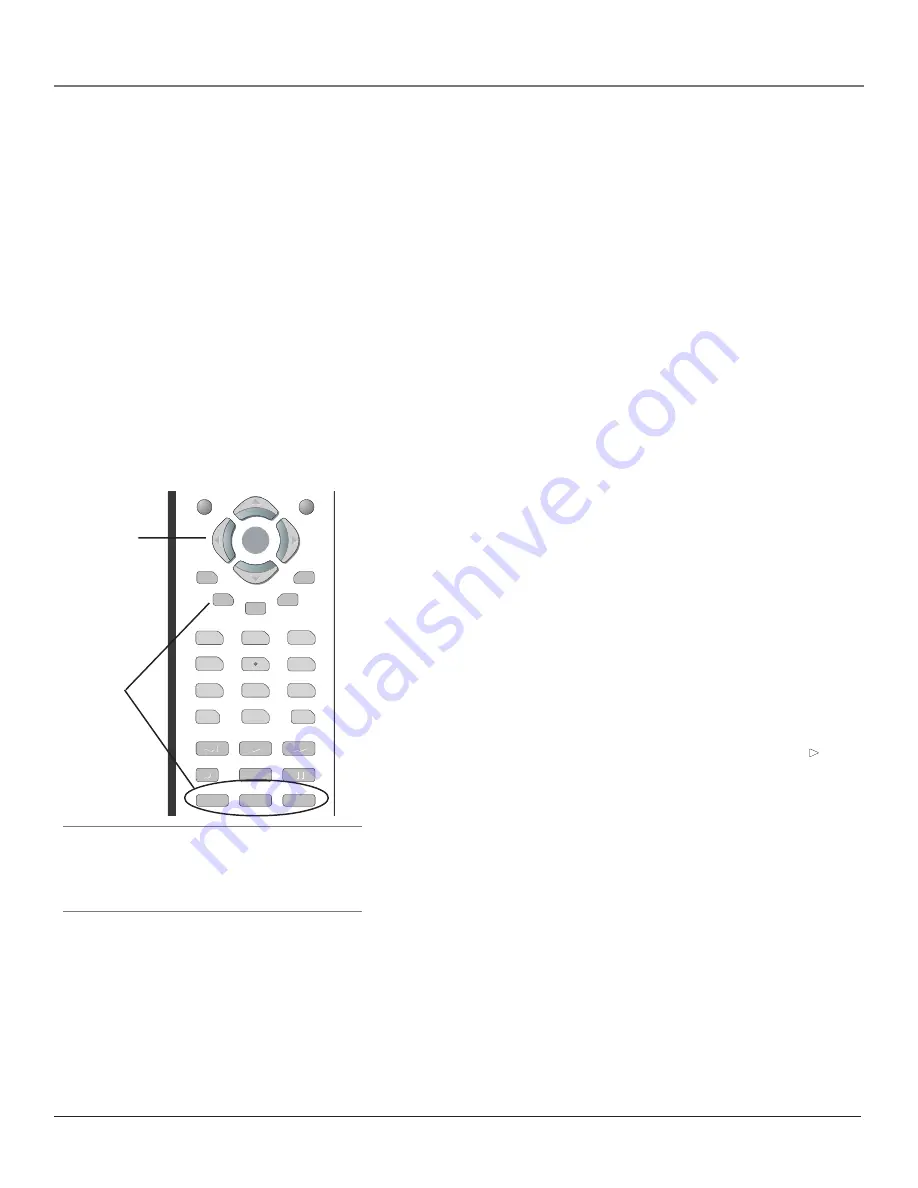
Using the TV’s Features
38
Chapter 3
Input 1
Component is connected to the Input 1 Video (
V
) or
S-VIDEO
jack on the back of the TV and you want
the TV to tune to the Video Input Channel when you press the corresponding button.
Input 2
Compatible video source, such as a DVD player or satellite receiver, is connected to the Input 2
COMPONENT/COMPOSITE INPUT
jacks (Y/Video, Pb, Pr) on the back of the TV and you want the TV to tune to
the composite/component video input when you press the corresponding button.
Front Input
Component is connected to the
S-VIDEO IN
or
VIDEO IN
jack on the front of the TV and you want the
TV to tune to the front Video Input Channel when you press the corresponding button.
HDMI/DVI
Component is connected to the
HDMI/DVI
jack on the back of the TV and you want the TV to
tune to this input when you press the corresponding button.
PIP (Picture-in-Picture) Operation
The PIP (Picture-In-Picture) feature lets you display a second, smaller analog (NTSC format) picture on top of
the main analog picture. You will only be able to use the PIP window and main picture with analog channels
and inputs; PIP doesn’t support digital signals. The main and PIP channels must be from different tuners; you
must have the main picture from CABLE INPUT and the PIP picture from ANTENNA INPUT, or vice-versa.
PIP Buttons
There are certain remote buttons that control the way the PIP window
works:
PIP
Brings up the PIP window. Press PIP again to remove the window.
Arrows
Let you move the PIP window to different areas of the screen.
SWAP
Switches the video from the PIP window to the main picture.
FREEZE
Freezes entire screen, including the main picture and PIP
window, if PIP is displayed.
CH CTRL
(Channel Control) Lets you switch channel control between
the PIP window and the main picture. To determine whether you are
controlling the PIP or the main picture, look at the channel banner as you
change channels or press INFO button. The triangular indicator ( ) beside
the channel number lets you know which picture you’re controlling with
channel up/down, number buttons, etc.
Using the PIP Feature
The PIP feature is only available for analog (NTSC) channels; PIP won’t
work when tuned to a digital (ATSC) channel. Use the channel banner to
determine whether a channel is digital or analog. A digital (ATSC) channel
has a dash and second number after it (e.g., 21-2); an analog channel
doesn’t (e.g., Ch 21). While you may use PIP in different ways, this basic
PIP scenario should get you started. When watching an analog channel,
follow these steps.
1.
Press the PIP button on the remote control. The PIP window appears
on the screen and
Channel Control
is automatically set to the PIP
window.
Tip
If you want to go directly to an input or channel in PIP
(or main), set up auto tuning and press the component
button (AUX orDVD).
Arrow
buttons
PIP
buttons
CLEAR
MENU
FORMAT
FREEZE
GUIDE
INFO
SKIP
1
2
3
4
5
6
7
8
9
0
INPUT
ANT•CAB
REVERSE
PLAY
FORWARD
RECORD
STOP
PAUSE
PIP
SWAP
CH CTRL
OK
OK
16339320.03 Features
5/27/04, 4:03 PM
38
Summary of Contents for HD52W55
Page 1: ...High Definition Television User s Guide Changing Entertainment Again ...
Page 20: ...This page intentionally left blank ...
Page 28: ...This page intentionally left blank ...
Page 42: ...This page intentionally left blank ...
Page 73: ...This page intentionally left blank ...
Page 74: ...This page intentionally left blank ...
Page 75: ...This page intentionally left blank ...
Page 76: ...This page intentionally left blank ...
Page 77: ...This page intentionally left blank ...
Page 78: ...This page intentionally left blank ...






























